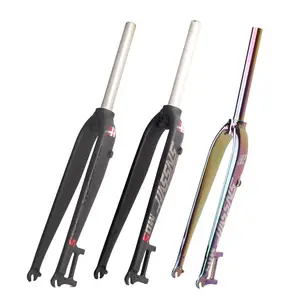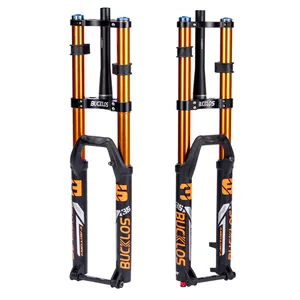(105031 products available)





























































































































































































































Here are some common types of bike forks that can be found on the market:
Rigid Forks
Rigid forks are built without suspension systems. They offer a precise steering response and are lighter than suspended alternatives. However, they transfer more vibrations from the terrain to the bike. Rigid forks are ideal for smooth surfaces and off-road racing on uneven terrain.
Suspension Forks
Suspension forks absorb shocks and bumps by minimizing rider fatigue. They enhance control and provide a smoother ride. Suspension forks are excellent for trail and mountain biking. They are heavier than rigid alternatives and may reduce pedaling efficiency on smooth terrain.
Hardtail Forks
Hardtail forks have a suspended front end and a rigid rear end. They are lighter than full-suspension bikes and provide more power when climbing hills. Hardtail forks are excellent for cross-country and trail biking. However, they transfer more shocks to the rider than full-suspension alternatives.
Carbon Forks
Carbon forks are constructed with a fiber-reinforced polymer. They are lighter than metal forks and offer a high level of vibration dampening. This makes them stiffer and more durable. Carbon forks are rigid by nature and provide better performance than metal forks. They are also more expensive.
Disc Brake Forks
Disc brake forks are designed with mounts for disc brakes. They offer consistent and reliable braking power. Disc brake forks perform better in wet and rough conditions. They are used in mountain biking and off-road cycling. Bikes with rim brakes are lighter and have less braking power in rough conditions than disc brakes.
Cantilever Forks
Cantilever forks are built with long arms that pivot on a central point. They are simple to maintain and have excellent mud clearance. Cantilever forks are used in cyclocross and touring bikes. They are heavier than modern alternatives and offer less braking power than disc brakes.
Threadless Forks
Threadless forks are constructed with a steerer tube that is not threaded. They are lighter and stiffer than threaded alternatives, providing precise steering. Threadless forks are easier to install and maintain. However, they are less adaptable to different headset types. They are used in modern bikes.
Bike forks are essential components that provide stability, control, and comfort to bicycles. Their usage scenarios vary widely depending on the type of cycling and the specific requirements of different bike categories. Here are some key usage scenarios:
Mountain Biking: Forks for mountain bikes are designed to handle rough terrains, rocky paths, and steep declines. They absorb shocks and bumps, offering greater control and stability. These bikes can have either rigid or suspension (shock absorbing) forks. Suspension forks, further divided into hardtail and full-suspension forks, are more common and advantageous when traversing uneven landscapes. Adjustable travel suspension forks are particularly beneficial for varied terrain, allowing customization of shock absorption.
Road Cycling: Cyclists who enjoy speed and smoothness on paved roads typically use rigid forks. However, to improve comfort and control on less-than-perfect roads, some road bikes now come equipped with light-weight carbon fork bike options that feature minimal suspension. These forks enhance shock absorption without adding significant weight, maintaining the bike's speed and agility.
Touring and Adventure Cycling: These forks are built to support heavier loads and navigate various terrains, from smooth pavements to bumpy gravel paths. They are often used with panniers and other touring gear. Some adventure bikes are even equipped with suspension forks to increase comfort and control on rough terrains, making them suitable for off-road exploration.
BMX and Freestyle Riding: BMX bikes use rigid forks because of their lightweight and simplicity, offering increased strength and responsiveness. However, forks for freestyle BMX are specifically designed to endure the impacts of jumps, tricks, and rough landings. They are often reinforced and have precise geometry to enhance durability and performance in freestyle riding.
Urban and Commuter Cycling: These bikes often feature forks with integrated suspension systems, particularly shallow travel forks, to smooth out bumps and potholes in city streets. This improves comfort and reduces fatigue during daily commutes. Additionally, some urban bikes come with sturdier forks to support racks, fenders, and other accessories, increasing their practicality for city commuting.
Racing and Competitive Cycling: Racing bikes prioritize speed, agility, and weight. As such, carbon fiber bike forks are the go-to option due to their light weight and stiffness, which translates to improved power transfer and responsiveness. These forks, especially in high-end racing scenarios, may also feature advanced engineering designs to optimize aerodynamics and overall performance.
The right bike fork is crucial for a good ride. Here are the main things to think about when getting a new bike fork:
riding style
Each bike fork is made for a particular riding style and has features that suit that style. For instance, if one likes mountain biking, a rigid fork or one with suspension is preferable because it can handle rough terrain. Similarly, a road bike fork is made with materials that are lightweight and stiff, making it more suitable for road cycling.
Bike compatibility
It is important to ensure that the new bike fork fits well with the bike. This involves considering the bike's wheel size, frame material, and mounting points. For instance, a fork made for 29-inch wheels will not fit a bike with 26-inch wheels. Likewise, a fork with disc brake mounts will not fit a bike frame made for rim brakes only.
Rider comfort
A bike fork has a direct influence on how comfortable one will be when riding. A fork with more suspension travel absorbs bumps better, resulting in a smoother ride on rough terrain. On the contrary, a fork with less suspension travel is stiffer and offers better responsiveness, which is ideal for riders who prefer a more connected feeling when riding.
Durability
Another factor to consider is the durability of the bike fork. Bike forks are made of different materials, and each has its pros and cons. For instance, carbon forks are lightweight and stiff, but they are more expensive and less durable than aluminum forks. Conversely, aluminum bike forks are more durable but heavier.
Budget
When selecting a bike fork, it is important to consider how much one can spend. Bike forks vary in price based on their make and features. High-end forks with adjustable suspension settings and air spring systems are more expensive than rigid or entry-level forks. While it is crucial to select a fork that is within the intended budget, it is also essential to ensure that it meets the required performance specifications and durability expectations.
Understanding the functions, features, and designs of bike forks will help companies know the right fork to choose for their customers.
The main function of a bike fork is to hold the front wheel and provide stability. It connects the front wheel to the bike frame and supports the bike's weight. It also absorbs shock from bumps on the road, which ensures a smooth and comfortable ride.
Material
Bike forks can be made from different materials, such as carbon fiber, steel, aluminum, and titanium. The material used will affect the fork's weight, durability, and performance.
Brake Compatibility
Bike forks can have different brake compatibilities, such as disc or rim brakes. Some forks are designed for specific brake types and may not be compatible with others.
Mounting options
Some bike forks come with mounting options that allow cyclists to attach accessories, such as fenders, racks, and mudguards.
Travel
This is a feature of a suspension fork that refers to the distance the fork can compress. It varies depending on the type of bike and the intended use. For instance, mountain bikes have greater travel than road bikes.
Acer and Offset
The angle and offset of a bike fork will affect its handling. A fork with a shorter offset will be more responsive, while one with a longer offset will be more stable.
Crown
This is the part of the bike fork that connects the legs to the steerer tube. Forks can have different crown designs, which will affect their strength and handling.
Legs
Bike fork legs can have different designs, such as straight or curved. The design will affect the fork's aerodynamics and strength.
Q1. What is the difference between a straight and a tapered fork?
A1. A straight bike fork has the same diameter at the top and bottom of the steer tube, while a tapered fork is wider at the bottom and narrows at the top. The tapered fork offers better stiffness and handling, while the straight fork is more common in entry-level bikes.
Q2: Can a bike fork be repaired?
A2: In most cases, a bike fork cannot be repaired and will need to be replaced. However, if the issue is with the suspension and there are no major damages to the fork, then a suspension service can be done. This involves replacing seals and oil to restore the bike fork's performance.
Q3: How can I tell if a bike fork is compatible with my bike?
A3: To determine if a bike fork is compatible, one needs to check the frame's specifications. This includes the wheel size, brake type, axle size, and steer tube diameter. This information can be found online or in the bike's manual. Alternatively, one can take the bike to a local bike shop and get expert help.
Q4: What are some common issues with bike forks?
A4: Some common issues that cyclists face with bike forks include stiction, oil leakage, and play. Stiction occurs when the fork legs stick together, causing the suspension to be unresponsive. This is often due to dirt and grime getting into the seals. If there is oil leakage around the seals, this indicates that the seals are worn out and need replacement. Play refers to any unwanted movement in the fork that is not caused by the suspension. This is often due to loose bearings or a loose headset and can easily be fixed by tightening the bearings or headset.